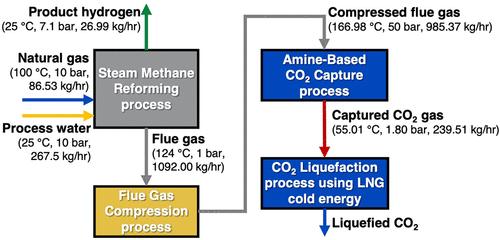当前位置:
X-MOL 学术
›
Ind. Eng. Chem. Res.
›
论文详情
Our official English website, www.x-mol.net, welcomes your feedback! (Note: you will need to create a separate account there.)
Utilization of Cold Energy of LNG for Carbon Dioxide Capture and Liquefaction in Amine-Based SMR
Industrial & Engineering Chemistry Research ( IF 3.8 ) Pub Date : 2024-06-26 , DOI: 10.1021/acs.iecr.3c03024 Hyeon-won Jeong 1 , Vinh Khanh Nguyen 2 , Shu Wang 3 , Ricardo Gutfraind 3 , Ruichang Xiong 3 , Jerry Wareck 3 , Samantha Neilsen 3 , W. Jaewoo Shim 1
Industrial & Engineering Chemistry Research ( IF 3.8 ) Pub Date : 2024-06-26 , DOI: 10.1021/acs.iecr.3c03024 Hyeon-won Jeong 1 , Vinh Khanh Nguyen 2 , Shu Wang 3 , Ricardo Gutfraind 3 , Ruichang Xiong 3 , Jerry Wareck 3 , Samantha Neilsen 3 , W. Jaewoo Shim 1
Affiliation

|
Hydrogen is widely produced by a steam methane reforming (SMR) process, but CO2 that is produced as a byproduct needs to be captured. For this purpose, amine absorption, one of the main carbon capture and utilization (CCU) techniques, is commonly integrated with the SMR process. A drawback of the amine absorption process is that captured CO2 is recovered in the gas phase and must be liquefied or solidified to be suitable for transportation and storage. Traditionally, the liquefaction of CO2 is achieved by a series of compression-cooling and expansions (e.g., the Linde–Hampson process), which is a costly and energy-intensive process. This study proposes using liquefied natural gas (LNG) not only as the source for hydrogen production and heat supply for the SMR reaction, but also to provide the necessary thermal energy requirement for the liquefaction of CO2 using plate-fin heat exchangers. Aspen HYSYS is used to simulate a 300 Nm3/h scale SMR process, the amine absorber, and CO2 Liquefaction processes. Energy, exergy, and cost efficiencies for a conventional Linde–Hampson process and two novel setups utilizing LNG cold energy are studied and compared. In summary, our results show the significant advantages of the proposed nonrecycling process over the conventional Linde–Hampson system. Specifically, it offers up to a 39.38% enhancement in overall exergy efficiency, achieves a net rational exergy efficiency as high as 95.72%, and reduces total capital costs by 30.83%.
中文翻译:

胺基SMR中利用LNG冷能捕集和液化二氧化碳
氢气广泛通过蒸汽甲烷重整 (SMR) 工艺生产,但作为副产品产生的 CO 2 需要捕获。为此,胺吸收作为主要的碳捕获和利用 (CCU) 技术之一,通常与 SMR 工艺集成。胺吸收过程的缺点是捕获的CO 2 在气相中回收,必须液化或固化才能适合运输和储存。传统上,CO 2 的液化是通过一系列压缩冷却和膨胀(例如林德-汉普森工艺)来实现的,这是一个成本高昂且能源密集型的过程。本研究提出使用液化天然气(LNG)不仅作为SMR反应的氢气生产和供热来源,而且还为使用板式液化CO 2 提供必要的热能需求。翅片式热交换器。 Aspen HYSYS 用于模拟 300 Nm 3 /h 规模的 SMR 过程、胺吸收器和 CO 2 液化过程。研究并比较了传统林德-汉普森工艺和两种利用液化天然气冷能的新型装置的能源、火用和成本效率。总之,我们的结果表明,与传统的林德-汉普森系统相比,所提出的非回收工艺具有显着优势。具体来说,整体火用效率提升高达39.38%,净理性火用效率高达95.72%,总资本成本降低30.83%。
更新日期:2024-06-26
中文翻译:

胺基SMR中利用LNG冷能捕集和液化二氧化碳
氢气广泛通过蒸汽甲烷重整 (SMR) 工艺生产,但作为副产品产生的 CO 2 需要捕获。为此,胺吸收作为主要的碳捕获和利用 (CCU) 技术之一,通常与 SMR 工艺集成。胺吸收过程的缺点是捕获的CO 2 在气相中回收,必须液化或固化才能适合运输和储存。传统上,CO 2 的液化是通过一系列压缩冷却和膨胀(例如林德-汉普森工艺)来实现的,这是一个成本高昂且能源密集型的过程。本研究提出使用液化天然气(LNG)不仅作为SMR反应的氢气生产和供热来源,而且还为使用板式液化CO 2 提供必要的热能需求。翅片式热交换器。 Aspen HYSYS 用于模拟 300 Nm 3 /h 规模的 SMR 过程、胺吸收器和 CO 2 液化过程。研究并比较了传统林德-汉普森工艺和两种利用液化天然气冷能的新型装置的能源、火用和成本效率。总之,我们的结果表明,与传统的林德-汉普森系统相比,所提出的非回收工艺具有显着优势。具体来说,整体火用效率提升高达39.38%,净理性火用效率高达95.72%,总资本成本降低30.83%。
















































 京公网安备 11010802027423号
京公网安备 11010802027423号